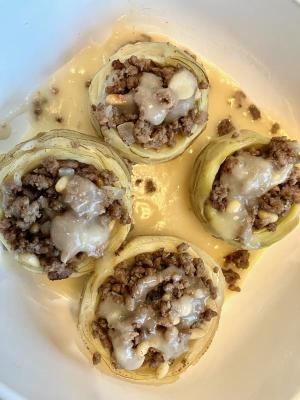Every time my friend Lina comes to visit, she brings artichokes, typically a generous selection of quartered hearts in a tangy vinaigrette. Most recently, she came with bags of frozen artichokes, some hearts and some bottoms. To those not familiar with this peculiar vegetable, some explanation might be in order.
The globe artichoke, also called a French artichoke or green artichoke, is a perennial thistle plant and a member of the sunflower family. Plants grow quite large in diameter and about three or four feet tall. The edible part is actually the flower bud, which is harvested before it blooms.
One name for the plant derives from the Italian words “articiocco” and “articoclos,” the latter of which comes from a word meaning pine cone, a reasonable description of its appearance. They originated in the Mediterranean region, with mentions dating back as early as 390 B.C. when the Greek philosopher Theophrastus wrote of them being grown in Italy and Sicily.
Ancient Romans enjoyed eating artichokes year round as the plants thrived in the temperate climate. Food historians report the wealthy prepared them in honey and vinegar, seasoned with cumin. By the time of the first century A.D., the Moors of Northern Africa were cultivating artichokes in Granada, Spain and the Saracens became associated with artichokes in Sicily.
Over the next 1,500 years the plant was widely cultivated throughout Europe, arriving in France and England in the sixteenth century. An apocryphal story of the time describes the Queen mother becoming ill after eating so many artichoke bottoms at a wedding reception. Widely considered an aphrodisiac, it comes as no surprise they were on the menu at the wedding.
Artichokes arrived in the United State in the eighteen-hundreds, brought by French immigrants to Louisiana and Spaniards to the Monterey area of California. During the decades that followed, cultivation became concentrated in California where today almost all the artichokes in this country are commercially produced.
Artichokes have been widely found in the pages of early recipe books, including Martha Washington’s Hartichoke Pie and Thomas Jefferson’s Braised Artichokes.
When selecting artichokes at the market, look for those that are deep green with a tight leaf formation. They should be heavy for their size and squeak slightly when you squeeze them. Brown discoloration on the tips of the leaves can be age-related or simply an indication of mild frost damage. During the fall and winter, look for tender green on the inside of the petals to see if they are simply “winter kissed” and not too old.
To eat an entire steamed artichoke, one starts by cutting off the stem to create a flat, stable base. The vegetable is placed in a pan with water and cooked until soft and tender. Each of the leaves are removed, one at a time, dipped into melted butter and the diner scrapes it through their teeth to extract the edible portion at the bottom of the leaf. Once all the leaves are gone, it’s time to harvest the meaty heart in the center by scraping out the fuzzy center.
In addition to fresh artichokes, you can also fine them canned, marinated, and frozen. The challenge with frozen artichokes is that they must be defrosted and drained to avoid adding excess water to your recipe. One other caveat about artichokes, is they contain the acid cynarin, which causes foods and wines served with them to taste sweet, so pair carefully.
For the artichoke bottoms in the photo, we followed a traditional Lebanese recipe that combines ground beef with spices, pine nuts, and a lemony sauce. Along with that recipe, I’ve included a traditional artichoke favorite, a creamy baked dip that can be enhanced with crabmeat.
Stuffed Artichoke Bottoms
15 oz bag frozen artichoke bottoms
1 T butter
1 T flour
1 C chicken broth
1/4 t garlic powder
pinch salt
1/4 C lemon juice
1 T olive oil
1 diced onion
2 crushed garlic cloves
1 lb ground beef
1/3 C toasted pine nuts
1 t allspice
1/2 t cinnamon
1/2 t nutmeg
1/2 t salt
1/2 t pepper
Preheat oven to 350 F. Thaw artichoke bottoms or steam for 15 minutes; dry completely and place in a baking dish. Melt the butter in a small pan, sprinkle with flour and cook until golden. Add broth, garlic powder, salt, and lemon juice. Cook, stirring constantly until smooth and thickened; set aside. Heat the olive oil in a large skillet and add onion; sauté until softened. Add garlic and cook until fragrant, about 2 minutes. Push onion mixture to the side of the pan and add the beef. Cook, stirring constantly to break up the meat. When no longer pink, stir to mix in the onions and continue cooking until dry. Add pine nuts (reserving some for garnish) and spices; cook an additional two minutes. Fill the prepared artichoke bottoms with generous scoops of the meat mixture. Pour the sauce into the pan. Cover with foil and bake for 30 minutes. Serve with Basmati rice, garnish with remaining pine nuts. Yield: 6 servings.
Baked Artichoke Dip
1 C mayonnaise
1 C grated Parmesan cheese
1/2 C grated onion
13-oz can artichoke hearts, drained
1 T lemon juice
1/4 t pepper
Preheat oven to 400 F. In a mixing bowl, whisk together mayonnaise, cheese and onion. Finely chop the artichokes or process briefly in a food processor. Stir artichoke into the mayonnaise mixture along with remaining ingredients. Transfer to a baking dish and cook until lightly browned, about 20 minutes. Serve with baguette slices or crackers. Yield: 2 1/2 C.






















































